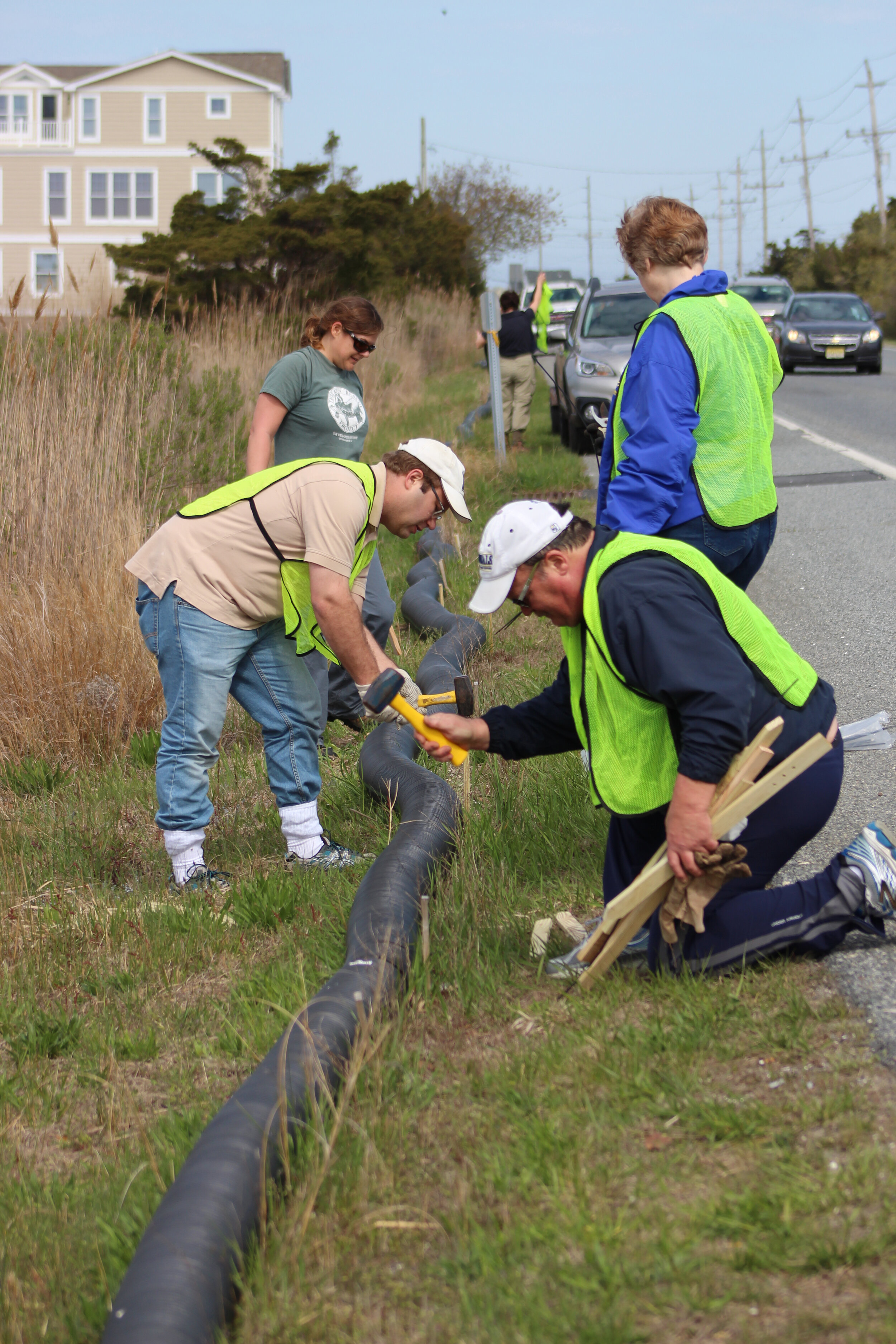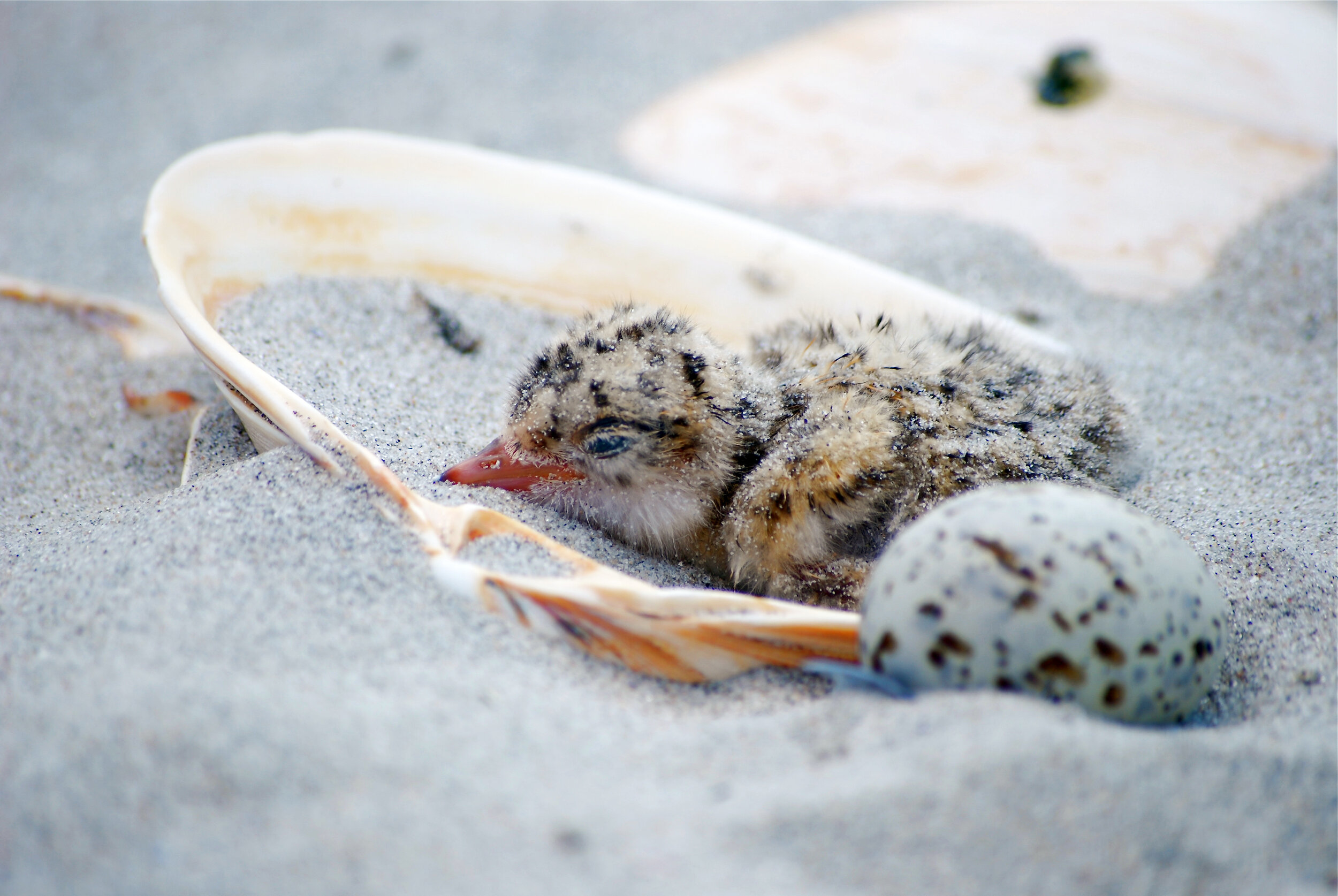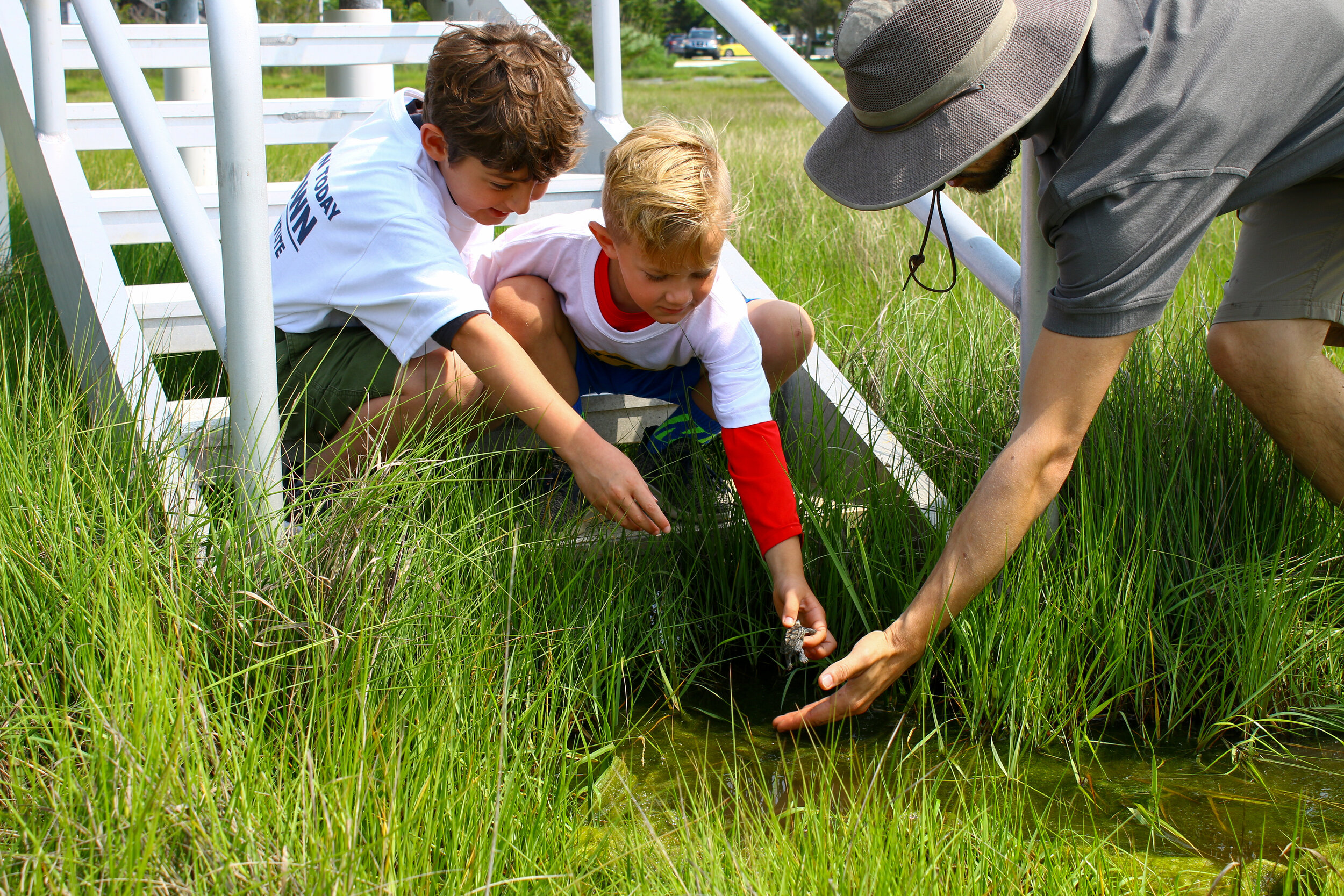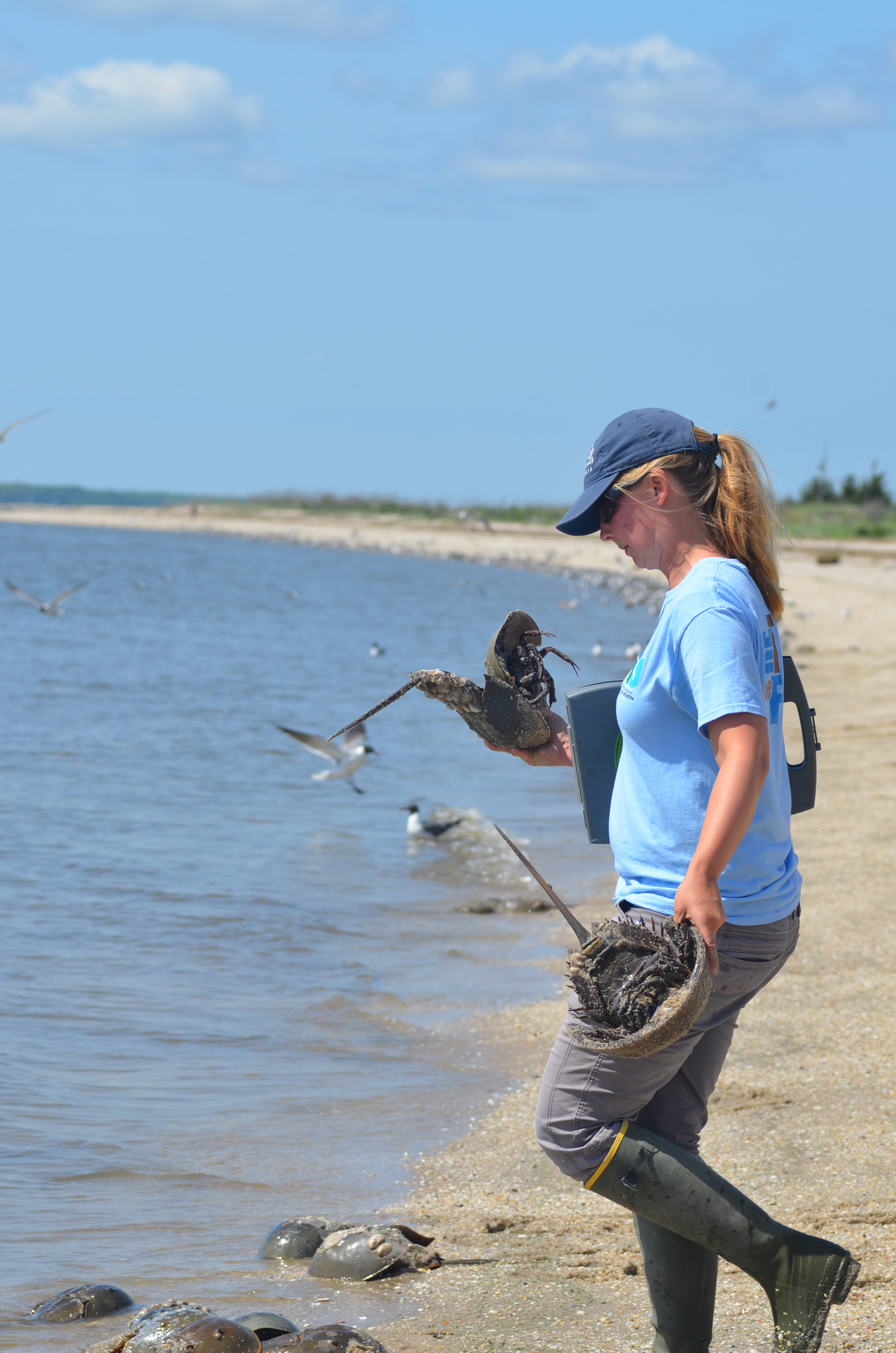The Challenges & Complexities of Wildlife Conservation
Black Skimmer adults and chicks.
Every summer, we are confronted with decisions about how to help conserve the wildlife around us. At The Wetlands Institute, we have several programs that seek to help restore wildlife populations through common-sense conservation. Our overarching approach is to work to find ways to help balance the needs and uses of people with those of sensitive wildlife to give them a chance at population stabilization and/or recovery. We work with several “sentinel species” and, by this, we mean species whose population health and well-being are indicators of the overall health of our ecosystems. We focus on populations that are at risk or in decline because their habitat and reproductive needs are at odds with the development, recreation and resource management needs of people.
I am frequently asked questions about why and how we help wildlife, or refrain from helping, and how we make decisions about the different approaches that are employed. Our activities require permits from federal and state agencies, and our work includes research to determine the most effective approaches and documenting the outcomes of our efforts. We use scientifically established best practices, and where possible contribute to advancing those best practices. I thought it would be helpful to provide some scientific background on this complex and often difficult topic. There are so many emotions that are often at play that it is important to have some of the science in the mix.
Summer at the shore brings many of us face-to-face with the plight of diamondback terrapins. These turtles emerge from the marsh to find places to nest and unfortunately end up on roadways where their survival rate is dramatically reduced. The terrapins that you may encounter are female terrapins seeking high ground to nest and lay eggs. Each one is at least eight years old and only leaves the protection of the marsh to nest. Her journey is dangerous and exhausting. Island development, bulkheads and rising seas have all decreased the available places she can nest, and the roadways that crisscross the marsh are some of the few remaining available nesting areas.
Car-terrapin interactions are widespread, and each nesting season, from late May through late July, The Wetlands Institute road patrols document more than 500 road-killed mothers. That’s more than 500 breeding-age adults that took at least eight years to reach maturity. From a population vulnerability standpoint, losses of these members of slow-maturing species lead to cumulative population declines. Protecting and saving breeding-age females is therefore a top conservation priority.
Roadside barrier fencing is designed to provide space for nesting but keep terrapins off roadways, and is an important tool. In areas where continuous barriers can be deployed, and well-maintained, they are quite effective. However, they can’t be installed on only one side of a road because then it serves to trap terrapins on the roadways. They also can’t be deployed where there are driveways and other roadway accesses. Signage and other awareness campaigns are in widespread use, yet the annual numbers indicate that there is much more to do.
Efforts to help keep terrapins off roadways have also included creating habitat that is attractive to nesting females away from roadways. A collaborative project between the Borough of Avalon and The Wetlands Institute has created nesting habitat for terrapins and is being studied for effectiveness. Unfortunately, another challenge is that terrapin nests suffer very high loss rates to predation. This is a natural part of the cycle except that the natural balance of predators to prey has been skewed dramatically in favor of the predators, again by the activities of people. Raccoons, skunks, foxes, and even crows now have much higher populations in our area than ever before, even as recently as five to 10 years ago. These so-called subsidized predators are flourishing because of increased food availability around humans, and the removal of their normal predators. The overall result is that there are fewer terrapins nesting in concentrated areas and there are higher numbers of nest predators.
All of these factors come into play in the development of wildlife conservation and management strategies. The Wetlands Institute uses nest exclosures on our property to protect nests from predation to help increase the number of natural nests that hatch. Our terrapin conservation is extensive and multifaceted and also includes recovering eggs from road-killed mothers, and incubating, hatching and releasing those babies back into the wild. Regardless of all of these interventions, by far the most important thing we can all do is avoid impacts to the breeding-aged adults. Slow down, be aware, and help that terrapin complete her mission of laying her eggs and making her way back to the marshes to come back again next year and help stabilize her population.
Horseshoe crabs are the second species that is an important conservation target for The Wetlands Institute. A combination of factors including sea-level rise, habitat loss, declining habitat quality, and overfishing all have played a role in their significant population declines. Horseshoe crabs are long-lived animals that don’t reach sexual maturity for 8-10 years. Population declines have resulted in much smaller concentrations of animals in spawning areas and in many fewer areas where they spawn. Concentrating wildlife into fewer areas is akin to putting all their eggs in one basket so that natural (and man-made) perturbations to their breeding success has dramatic consequences to their overall survival. Natural selection is no longer naturally at play.





In an effort to bolster the horseshoe crab populations in the Delaware Bay, an important nesting area for them, the reTURN the Favor program deploys a network of volunteers to rescue stranded crabs from beaches. They can simply become overturned and succumb to drying out or predation, or they become entrapped in shoreline structures including old bulkheads and jetties. Rescuing breeding-aged adults and ensuring they can return to their populations to continue to breed is a key conservation goal. Efforts to increase suitable habitat have included beach-nourishment projects and small restoration projects that remove or repair structures that are especially hazardous to the crabs. The reTURN the Favor horseshoe crab rescue program has saved more than 500,000 horseshoe crabs since the program started in 2013, likely helping to accelerate the recovery of horseshoe crabs in the Delaware Bay. As rising seas continue to reduce available nesting habitat, restoration projects and efforts to reduce man-made hazards become even more important tools to help spread the breeding population over more and more areas to help build resiliency.
Conservation of coastal birds is another important focus for scientists at The Wetlands Institute. Beach-nesting birds have suffered population declines due to a combination of natural and human-induced stressors including habitat loss to development and rising seas, space competition with people for recreation, and increased predation in the few places they can nest. Many species of beach-nesting birds are protected by state and federal laws because of these dramatic declines in their populations. Ongoing conservation programs seek to increase the number of birds that successfully nest and raise their young, and the number of places that the birds can nest.
Black skimmers are among my favorite birds. They are state endangered, which means that their prospects for survival in New Jersey are in immediate danger and assistance is needed to prevent future extinction in the state. Since 2013, the number of places they nest has been reduced from more than 10 colonies to only five, statewide. Efforts to improve the success of existing colonies includes creating protected places for them to nest via partial or complete beach closures and improving nesting habitat for them. The Wetlands Institute has been working with the U.S. Fish and Wildlife Service in Cape May and the Borough of Stone Harbor using beach stewards to educate the public about the needs of coastal birds and helping to ensure that people comply with the recreational-use restrictions on the beaches where they are nesting. We have been working with the U.S. Army Corps of Engineers and the New Jersey Department of Environmental Protection to create new nesting habitats using clean sand dredged from the Intracoastal Waterway. These habitats are helping to combat the impacts of rising seas, spread out the colonies for resilience, provide them nesting opportunities away from the competition for space from people, and provide an added layer of protection from predators by moving them from the barrier islands to the marshes.
Understanding the plight of many of the wonderful species that surround us, and our role in impacting their populations, is an important first step in helping maintain and recover populations. All of us at The Wetlands Institute work very hard to find ways to balance the needs of wildlife with the needs of people. Unfortunately, these needs are often in direct competition. I ask myself every day how I can lighten my footprint and how I can help these animals – and many others I didn’t write about – be successful. How can I give them a little space to coexist with us? Perhaps you can, too.

